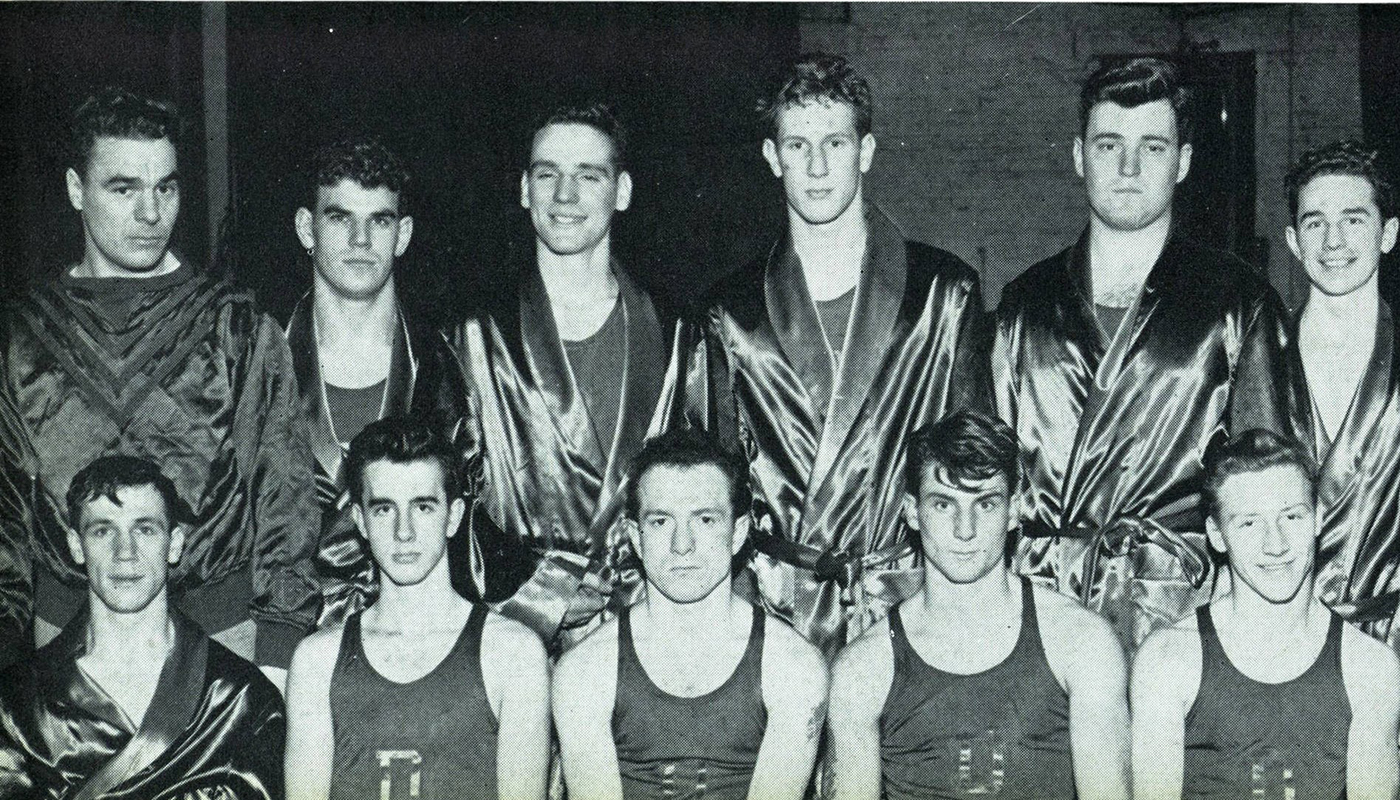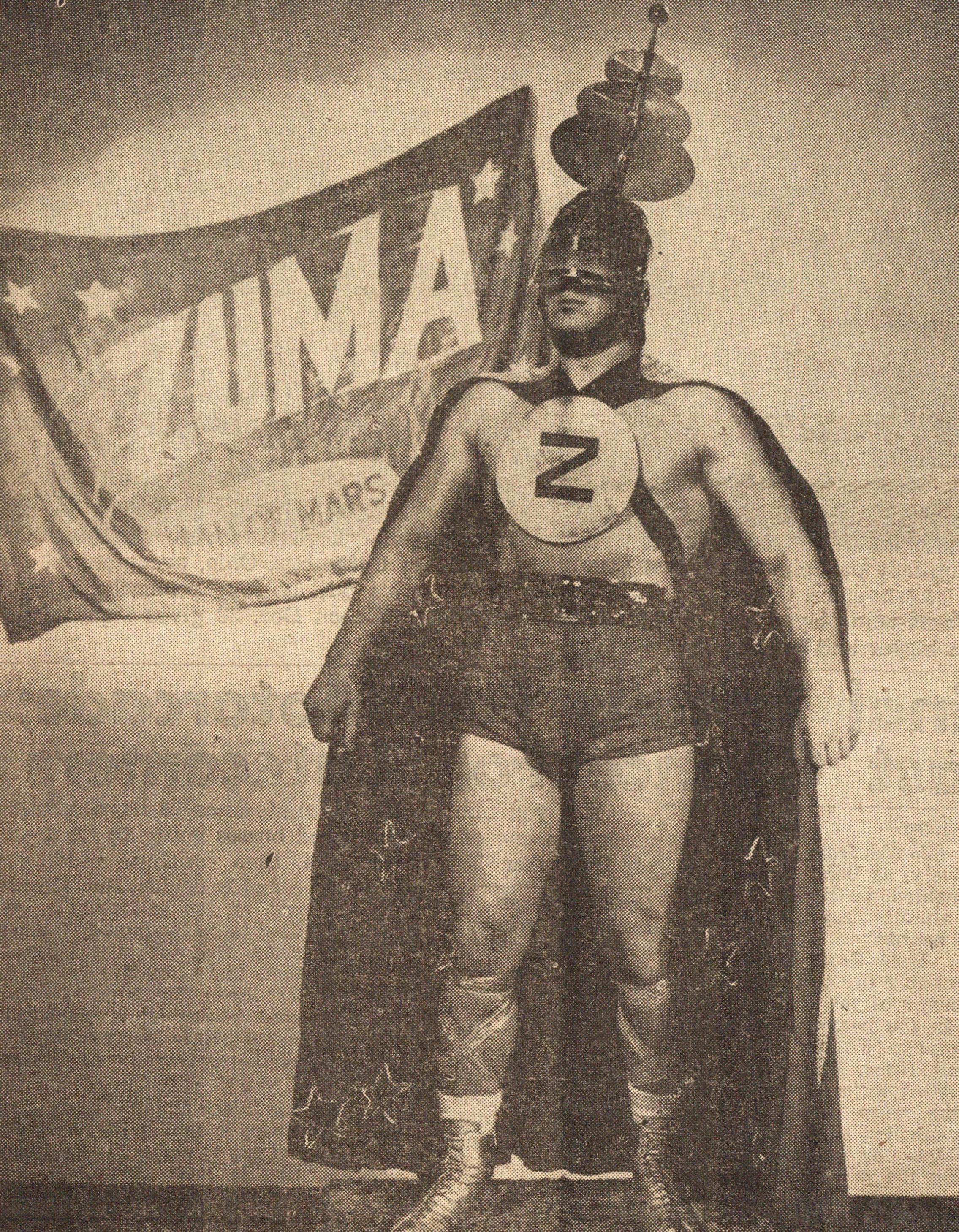 The 1948-49 DePaul University boxing team with coach Paul Mall (top row, first from left) and Engstrom (top row, second from left). (Image courtesy of Special Collections and Archives)
The 1948-49 DePaul University boxing team with coach Paul Mall (top row, first from left) and Engstrom (top row, second from left). (Image courtesy of Special Collections and Archives)
In 1950, the world of wrestling was introduced to a masked competitor that called himself “Zuma, Man of Mars." Also known as The Great Zuma, the man entered the ring wearing a long cape secured with a chest plate bearing the letter “Z," and an otherworldly headpiece with an antenna-like top that concealed his face. Zuma gained popularity on the wrestling circuit during his debut year, garnering attention for being quick on his feet and winning the majority of his matches. It was that fancy footwork—and a striking resemblance—that ultimately unveiled the true identity of the mysterious Martian to be Carl J. Engstrom, a DePaul student and former star boxer for the university.
 The Great Zuma. (Image courtesy of Special Collections and Archives)
The Great Zuma. (Image courtesy of Special Collections and Archives)
Engstrom was a student in DePaul's College of Physical Education in 1947, the year the university inaugurated boxing as a major sport. Before then, DePaul's last attempt at boxing came in 1933 when the Rev. Michael J. O'Connell, C.M., then vice president of the university, sponsored an intramural boxing and wrestling show in hopes of increasing interest in establishing the sports at DePaul. While Fr. O'Connell's aspirations didn't take hold, in the fall of 1947 the university charged Paul Mall, an instructor in the College of Physical Education, with leading an intercollegiate boxing team and preparing DePaul's entry into the Catholic Youth Organization's boxing tournament.
Mall came to the charge with several years of left-jab experience, after boxing at Pennsylvania State and spending a few years in the professional ring following graduation. He quickly put together tryouts for a squad at DePaul, made team selections, and began workouts and preliminary bouts, in preparation for the CYO tournament. Among those selected for the first squad and singled out as showing some of the most promise was heavyweight Carl Engstrom, who weighed in at 184 pounds.
The Demon boxing squad performed well under Mall, bringing home middle and welterweight championships from the CYO tournament. Engstrom battled his way to the tournament's stadium finals, but was ultimately defeated in what was deemed a “questionable round." The Demons followed up the CYO tournament with five intercollegiate bouts against highly-favored teams from universities like Purdue and Loyola, emerging from the season undefeated.
Engstrom returned as a letterman for the 1948-49 season of boxing at DePaul. He had also been wrestling as an amateur in Illinois, and it was sometime during that second season with the Demons that he turned his focus to a full-time professional wrestling career. This led him away from the university to compete in the Pacific Northwest.
When “Zuma, Man of Mars" landed on Earth and made his grand entrance to the professional wrestling ring in Chicago in 1950, it had been a couple of years since anyone in the area had seen Engstrom in action. This allowed the mysterious masked wrestler to compete incognito for several matches. Chicago was at the center of professional wrestling and many of its matches were broadcast both locally and nationally. It wasn't long before Ed Pazdur, the former sports editor of “The DePaulia" who had followed and closely covered the Demons boxing team for the 1947-48 season—recognized the athlete hiding under disguise, revealing him as none other than Engstrom.
Engstrom was a good sport about the exposure.
“I believed that a character such as Zuma would arouse the imagination of the sports fans and give me the publicity I would not have under the name of Carl Engstrom. It has achieved its objective and I believe that the asset of the name Zuma is now going to help me immensely in going back to my right name," he told “The DePaulia" in 1950.
He returned to the ring as Carl Engstrom and competed under his own name in more than 700 matches over the course of his professional wrestling career, which lasted until 1973.
Engstrom later returned to DePaul to finish his degree, receiving a bachelor of science in physical education in 1959, and going on to teach in Chicago Public Schools. As for that fancy footwork that aided in his unmasking? Engstrom also was a member of a dance troupe for a year before getting into wrestling. He and his wife also ran the Engstrom School of Dance and Acrobatics in Oak Park, Illinois. From Demon to Martian, Carl Engstrom truly had a varied career that took him many places, as a boxer, a wrestler, a dancer and a teacher.